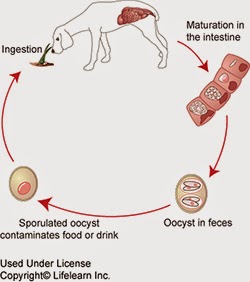Coccidiosis in
Lambs
·
There are 15 types of coccidian that may affect sheep. Only two are recognised to causing this disease in the UK; Eimeria
ovinoidalis and Eimeria crandallis.
·
Lambs take in coccidian oocysts (eggs) by oral route. Inside the gut the oocysts hatch, invade the gut cells and multiply dramatically. This leads to damage to the inside lining of the gut; as coccidia emerge by
bursting cells and this also dramatically increases
the amount of oocysts shed in the lambs
faeces. The amount of oocysts shed can be as much as million-times more
than were ingested.
·
Damage
to the cells lining the ileum, caecum
and colon results in diarrhoea which may contain mucus or blood. This may be accompanied by straining, pain, weight loss and possibly death of the lamb. Even animals that don’t show clinical
signs may show poor weight gain as the gut
has a reduced ability to absorb nutrients from food.
·
Source of
oocysts: low numbers of oocysts are shed by some ewes and oocysts from previous season lambs will survive overwinter. Lambs will then multiply these numbers dramatically.
·
Most often seen in lambs aged 4-8 weeks, not common over 3 months old.
·
Lambs are able to mount a good immune response to coccidian
so there is a lower risk if lambs are exposed to low levels earlier in life.
However, this low level exposition will contribute to environment infestation
of coccidian. Clinical disease is seen when young lambs are exposed to large amounts of coccidian. Such
situations include when: young lambs are moved to pastures previously grazed by older
lambs; lambs kept in extended clean conditions after birth are turned out
onto contaminated pasture. Immunity to one type of coccidia is not universal.
·
Nematodirus
is another common cause of diarrhoea and death in 6-12 week old lambs at grass
and may occur alongside coccidiosis.
·
Treatment:
during an outbreak, immediately either diclazuril
or toltrazuril should be given to all lambs over 3 weeks old. During an expected outbreak, when lambs are turned
out, 10-14 days after this date,
lambs should be treated with diclazuril. (as diclazuril has no residual
activity). However toltrazuril has a
longer duration; so only one dose is
necessary. Ideal timing is 7 days
after turn out, or before expected outbreak. Tzuril has shown to be more
effective than Dzuril.

0 comments:
Post a Comment